On October 13 we referred to the chart below as the most important chart on Wall Street. The gains in stocks over the past four sessions have allowed the broad NYSE Composite Index to push back above the important 10,301 level.

Why Is The Chart Helpful?
Between mid-2007 and early 2014, the stock market made no progress. The NYSE Composite was trading at 10,301 in 2007 and it hit 10,301 again in early 2014. The lack of progress, or period of consolidation, speaks to investor confusion/indecisiveness about the economy, earnings, valuations, stability of the financial system, and Fed policy. The break above 10,301 in early 2014 occurred when bullish conviction was strong enough to surpass a previously insurmountable level.

A Successful Retest Would Be Bullish
It is common for a "breakout" to be followed by a "retest". The blue arrow in the chart above can be classified as a "successful retest" as long as the NYSE Composite stays above 10,301. It closed Tuesday at 10,500.
We Learn Something Either Way
If the market fails to hold the key 10,301 level, it puts us back into the "failed breakout" category, which would be a yellow flag for equities.
The Longer The Consolidation...
Experienced money managers know the longer a market consolidates (investors remain indecisive), the bigger the move you typically see after a breakout. The broad stock market has been "basing" or consolidating for six years. A bullish breakout, followed by a successful retest, is difficult to ignore.
Can You Make A Fundamental Case?

Ultimately, the market makes that call, but we can review a few questions. Does the economy appear to be on the cusp of a recession? With real gross domestic product (the output of goods and services produced by labor and property located in the United States) having increased at an annual rate of 4.6 percent in the second quarter of 2014, a recession does not appear imminent. How about earnings? Bloomberg estimates that profits for S&P 500 companies rose 5.9 percent in the third quarter - that is not bear market-like earnings growth. How about central bank policy? The Fed is likely to keep rates low, even after ending QE, and the ECB is currently adding, not reducing, stimulative measures.
Investment Implications - The Weight Of The Evidence
During Tuesday's session, we noted the rationale for a measured approach when adding to equity holdings until the S&P 500 is able to hold above 1943. The S&P 500 closed just under that level at 1941 on Tuesday. Therefore, we have two good bull/bear reference points:
10,301 on the NYSE Composite 1,943 on the S&P 500
Is It Time To Get Back In?
Many investors have been sitting in cash waiting for a better entry point. Have we reached a better entry point? Only time will tell, but the odds of the answer being yes will start to improve if the S&P 500 can close above 1,943 and the NYSE Composite finishes the week above 10,301. The longer they remain above the levels, the higher the probability of good things happening.















